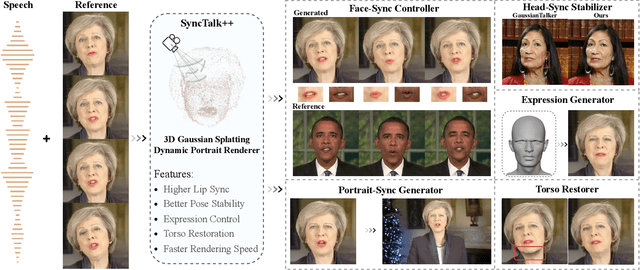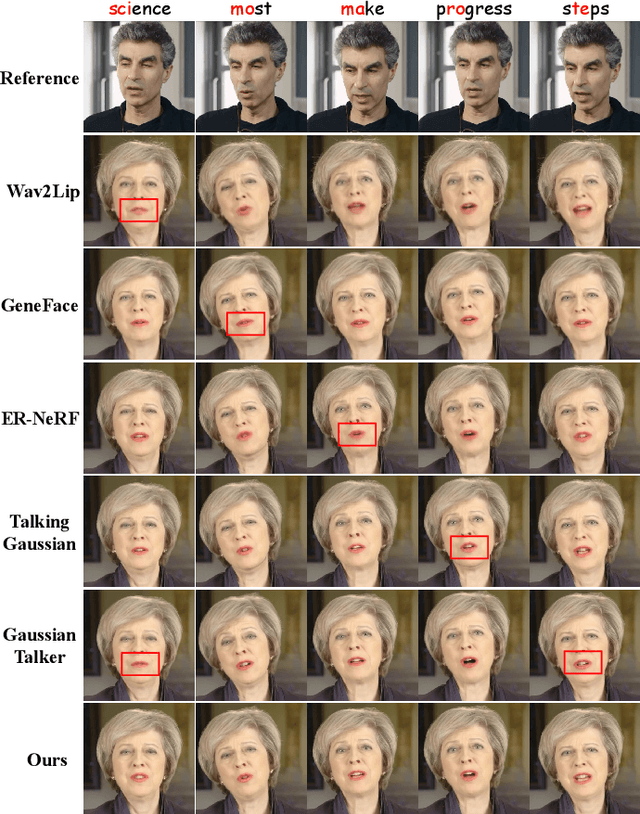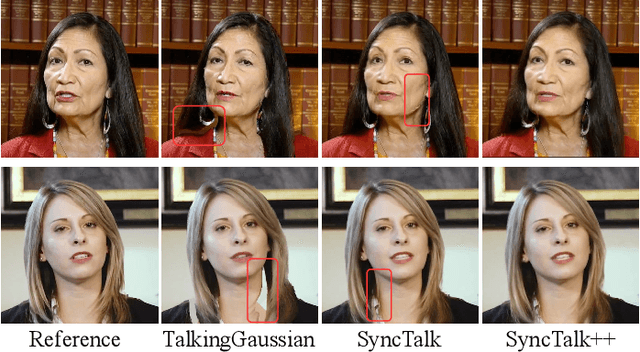Zhaoxin Fan
ActAvatar: Temporally-Aware Precise Action Control for Talking Avatars
Dec 22, 2025Abstract:Despite significant advances in talking avatar generation, existing methods face critical challenges: insufficient text-following capability for diverse actions, lack of temporal alignment between actions and audio content, and dependency on additional control signals such as pose skeletons. We present ActAvatar, a framework that achieves phase-level precision in action control through textual guidance by capturing both action semantics and temporal context. Our approach introduces three core innovations: (1) Phase-Aware Cross-Attention (PACA), which decomposes prompts into a global base block and temporally-anchored phase blocks, enabling the model to concentrate on phase-relevant tokens for precise temporal-semantic alignment; (2) Progressive Audio-Visual Alignment, which aligns modality influence with the hierarchical feature learning process-early layers prioritize text for establishing action structure while deeper layers emphasize audio for refining lip movements, preventing modality interference; (3) A two-stage training strategy that first establishes robust audio-visual correspondence on diverse data, then injects action control through fine-tuning on structured annotations, maintaining both audio-visual alignment and the model's text-following capabilities. Extensive experiments demonstrate that ActAvatar significantly outperforms state-of-the-art methods in both action control and visual quality.
Erased, But Not Forgotten: Erased Rectified Flow Transformers Still Remain Unsafe Under Concept Attack
Oct 01, 2025Abstract:Recent advances in text-to-image (T2I) diffusion models have enabled impressive generative capabilities, but they also raise significant safety concerns due to the potential to produce harmful or undesirable content. While concept erasure has been explored as a mitigation strategy, most existing approaches and corresponding attack evaluations are tailored to Stable Diffusion (SD) and exhibit limited effectiveness when transferred to next-generation rectified flow transformers such as Flux. In this work, we present ReFlux, the first concept attack method specifically designed to assess the robustness of concept erasure in the latest rectified flow-based T2I framework. Our approach is motivated by the observation that existing concept erasure techniques, when applied to Flux, fundamentally rely on a phenomenon known as attention localization. Building on this insight, we propose a simple yet effective attack strategy that specifically targets this property. At its core, a reverse-attention optimization strategy is introduced to effectively reactivate suppressed signals while stabilizing attention. This is further reinforced by a velocity-guided dynamic that enhances the robustness of concept reactivation by steering the flow matching process, and a consistency-preserving objective that maintains the global layout and preserves unrelated content. Extensive experiments consistently demonstrate the effectiveness and efficiency of the proposed attack method, establishing a reliable benchmark for evaluating the robustness of concept erasure strategies in rectified flow transformers.
Long-VLA: Unleashing Long-Horizon Capability of Vision Language Action Model for Robot Manipulation
Aug 28, 2025Abstract:Vision-Language-Action (VLA) models have become a cornerstone in robotic policy learning, leveraging large-scale multimodal data for robust and scalable control. However, existing VLA frameworks primarily address short-horizon tasks, and their effectiveness on long-horizon, multi-step robotic manipulation remains limited due to challenges in skill chaining and subtask dependencies. In this work, we introduce Long-VLA, the first end-to-end VLA model specifically designed for long-horizon robotic tasks. Our approach features a novel phase-aware input masking strategy that adaptively segments each subtask into moving and interaction phases, enabling the model to focus on phase-relevant sensory cues and enhancing subtask compatibility. This unified strategy preserves the scalability and data efficiency of VLA training, and our architecture-agnostic module can be seamlessly integrated into existing VLA models. We further propose the L-CALVIN benchmark to systematically evaluate long-horizon manipulation. Extensive experiments on both simulated and real-world tasks demonstrate that Long-VLA significantly outperforms prior state-of-the-art methods, establishing a new baseline for long-horizon robotic control.
Can Structured Templates Facilitate LLMs in Tackling Harder Tasks? : An Exploration of Scaling Laws by Difficulty
Aug 26, 2025



Abstract:Structured, procedural reasoning is essential for Large Language Models (LLMs), especially in mathematics. While post-training methods have improved LLM performance, they still fall short in capturing deep procedural logic on complex tasks. To tackle the issue, in this paper, we first investigate this limitation and uncover a novel finding: a Scaling Law by Difficulty, which reveals that model performance follows a U-shaped curve with respect to training data complexity -- excessive low-difficulty data impedes abstraction, while high-difficulty data significantly enhances reasoning ability. Motivated by this, we propose the Structured Solution Template (SST) framework, which uses solution templates and a curriculum of varied difficulty to explicitly teach procedural reasoning. Specifically, SST comprises (1) fine-tuning with structured solution-template chains and dynamically weighted loss to prioritize procedural logic, (2) prompt-time injection of solution templates as cognitive scaffolds to guide inference, and (3) integrated curriculum fine-tuning that explicitly teaches the model to self-plan - execute - self-correct. Experiments on GSM8K, AIME24, and new Dynamic En benchmark show that SST significantly improves both accuracy and efficiency, especially on harder problems.
HieroAction: Hierarchically Guided VLM for Fine-Grained Action Analysis
Aug 23, 2025Abstract:Evaluating human actions with clear and detailed feedback is important in areas such as sports, healthcare, and robotics, where decisions rely not only on final outcomes but also on interpretable reasoning. However, most existing methods provide only a final score without explanation or detailed analysis, limiting their practical applicability. To address this, we introduce HieroAction, a vision-language model that delivers accurate and structured assessments of human actions. HieroAction builds on two key ideas: (1) Stepwise Action Reasoning, a tailored chain of thought process designed specifically for action assessment, which guides the model to evaluate actions step by step, from overall recognition through sub action analysis to final scoring, thus enhancing interpretability and structured understanding; and (2) Hierarchical Policy Learning, a reinforcement learning strategy that enables the model to learn fine grained sub action dynamics and align them with high level action quality, thereby improving scoring precision. The reasoning pathway structures the evaluation process, while policy learning refines each stage through reward based optimization. Their integration ensures accurate and interpretable assessments, as demonstrated by superior performance across multiple benchmark datasets. Code will be released upon acceptance.
Mem4D: Decoupling Static and Dynamic Memory for Dynamic Scene Reconstruction
Aug 12, 2025Abstract:Reconstructing dense geometry for dynamic scenes from a monocular video is a critical yet challenging task. Recent memory-based methods enable efficient online reconstruction, but they fundamentally suffer from a Memory Demand Dilemma: The memory representation faces an inherent conflict between the long-term stability required for static structures and the rapid, high-fidelity detail retention needed for dynamic motion. This conflict forces existing methods into a compromise, leading to either geometric drift in static structures or blurred, inaccurate reconstructions of dynamic objects. To address this dilemma, we propose Mem4D, a novel framework that decouples the modeling of static geometry and dynamic motion. Guided by this insight, we design a dual-memory architecture: 1) The Transient Dynamics Memory (TDM) focuses on capturing high-frequency motion details from recent frames, enabling accurate and fine-grained modeling of dynamic content; 2) The Persistent Structure Memory (PSM) compresses and preserves long-term spatial information, ensuring global consistency and drift-free reconstruction for static elements. By alternating queries to these specialized memories, Mem4D simultaneously maintains static geometry with global consistency and reconstructs dynamic elements with high fidelity. Experiments on challenging benchmarks demonstrate that our method achieves state-of-the-art or competitive performance while maintaining high efficiency. Codes will be publicly available.
Undress to Redress: A Training-Free Framework for Virtual Try-On
Aug 11, 2025Abstract:Virtual try-on (VTON) is a crucial task for enhancing user experience in online shopping by generating realistic garment previews on personal photos. Although existing methods have achieved impressive results, they struggle with long-sleeve-to-short-sleeve conversions-a common and practical scenario-often producing unrealistic outputs when exposed skin is underrepresented in the original image. We argue that this challenge arises from the ''majority'' completion rule in current VTON models, which leads to inaccurate skin restoration in such cases. To address this, we propose UR-VTON (Undress-Redress Virtual Try-ON), a novel, training-free framework that can be seamlessly integrated with any existing VTON method. UR-VTON introduces an ''undress-to-redress'' mechanism: it first reveals the user's torso by virtually ''undressing,'' then applies the target short-sleeve garment, effectively decomposing the conversion into two more manageable steps. Additionally, we incorporate Dynamic Classifier-Free Guidance scheduling to balance diversity and image quality during DDPM sampling, and employ Structural Refiner to enhance detail fidelity using high-frequency cues. Finally, we present LS-TON, a new benchmark for long-sleeve-to-short-sleeve try-on. Extensive experiments demonstrate that UR-VTON outperforms state-of-the-art methods in both detail preservation and image quality. Code will be released upon acceptance.
Pose-RFT: Enhancing MLLMs for 3D Pose Generation via Hybrid Action Reinforcement Fine-Tuning
Aug 11, 2025Abstract:Generating 3D human poses from multimodal inputs such as images or text requires models to capture both rich spatial and semantic correspondences. While pose-specific multimodal large language models (MLLMs) have shown promise in this task, they are typically trained with supervised objectives such as SMPL parameter regression or token-level prediction, which struggle to model the inherent ambiguity and achieve task-specific alignment required for accurate 3D pose generation. To address these limitations, we propose Pose-RFT, a reinforcement fine-tuning framework tailored for 3D human pose generation in MLLMs. We formulate the task as a hybrid action reinforcement learning problem that jointly optimizes discrete language prediction and continuous pose generation. To this end, we introduce HyGRPO, a hybrid reinforcement learning algorithm that performs group-wise reward normalization over sampled responses to guide joint optimization of discrete and continuous actions. Pose-RFT further incorporates task-specific reward functions to guide optimization towards spatial alignment in image-to-pose generation and semantic consistency in text-to-pose generation. Extensive experiments on multiple pose generation benchmarks demonstrate that Pose-RFT significantly improves performance over existing pose-specific MLLMs, validating the effectiveness of hybrid action reinforcement fine-tuning for 3D pose generation.
SyncTalk++: High-Fidelity and Efficient Synchronized Talking Heads Synthesis Using Gaussian Splatting
Jun 17, 2025



Abstract:Achieving high synchronization in the synthesis of realistic, speech-driven talking head videos presents a significant challenge. A lifelike talking head requires synchronized coordination of subject identity, lip movements, facial expressions, and head poses. The absence of these synchronizations is a fundamental flaw, leading to unrealistic results. To address the critical issue of synchronization, identified as the ''devil'' in creating realistic talking heads, we introduce SyncTalk++, which features a Dynamic Portrait Renderer with Gaussian Splatting to ensure consistent subject identity preservation and a Face-Sync Controller that aligns lip movements with speech while innovatively using a 3D facial blendshape model to reconstruct accurate facial expressions. To ensure natural head movements, we propose a Head-Sync Stabilizer, which optimizes head poses for greater stability. Additionally, SyncTalk++ enhances robustness to out-of-distribution (OOD) audio by incorporating an Expression Generator and a Torso Restorer, which generate speech-matched facial expressions and seamless torso regions. Our approach maintains consistency and continuity in visual details across frames and significantly improves rendering speed and quality, achieving up to 101 frames per second. Extensive experiments and user studies demonstrate that SyncTalk++ outperforms state-of-the-art methods in synchronization and realism. We recommend watching the supplementary video: https://ziqiaopeng.github.io/synctalk++.
RoboPARA: Dual-Arm Robot Planning with Parallel Allocation and Recomposition Across Tasks
Jun 07, 2025Abstract:Dual-arm robots play a crucial role in improving efficiency and flexibility in complex multitasking scenarios. While existing methods have achieved promising results in task planning, they often fail to fully optimize task parallelism, limiting the potential of dual-arm collaboration. To address this issue, we propose RoboPARA, a novel large language model (LLM)-driven framework for dual-arm task parallelism planning. RoboPARA employs a two-stage process: (1) Dependency Graph-based Planning Candidates Generation, which constructs directed acyclic graphs (DAGs) to model task dependencies and eliminate redundancy, and (2) Graph Re-Traversal-based Dual-Arm Parallel Planning, which optimizes DAG traversal to maximize parallelism while maintaining task coherence. In addition, we introduce the Cross-Scenario Dual-Arm Parallel Task dataset (X-DAPT dataset), the first dataset specifically designed to evaluate dual-arm task parallelism across diverse scenarios and difficulty levels. Extensive experiments on the X-DAPT dataset demonstrate that RoboPARA significantly outperforms existing methods, achieving higher efficiency and reliability, particularly in complex task combinations. The code and dataset will be released upon acceptance.
 Add to Chrome
Add to Chrome Add to Firefox
Add to Firefox Add to Edge
Add to Edge